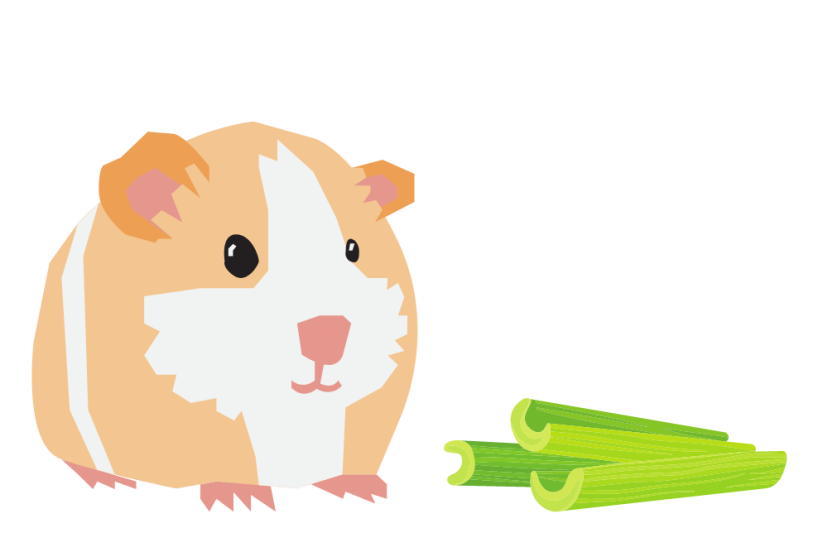Can Guinea Pigs Eat Celery? An Enthusiast’s Guide
Guinea pigs, our adorable and furry companions, have specific dietary needs. Like any caring owner, I’ve often wondered, “Can guinea pigs eat celery and enjoy the crunchy goodness?”
Let’s dive in.
Introduction to Guinea Pigs and Celery
Ever watched a guinea pig munch on something crunchy? Their little faces radiate joy! But before introducing a new treat, it’s essential to do our research.
Why Consider Celery?
Celery is a common vegetable found in many households. It’s known for its crisp texture and refreshing taste, often enjoyed by humans in salads, soups, or even as a standalone snack with some dips. But beyond the culinary world, what makes celery a topic of interest for guinea pig owners?
1. Natural Composition: Celery is primarily made up of water. This high water content can help in hydrating our little furballs, especially during warmer months. Keeping our guinea pigs hydrated is crucial for their overall health.
2. Low-Calorie Snack: One of the advantages of celery is its low calorie content. This means that, in moderation, it can be a guilt-free treat for our pets without the risk of adding unnecessary weight.
3. Rich in Nutrients: While it might seem like a watery vegetable with not much to offer, celery is a source of essential nutrients. It provides vitamins and minerals that can benefit our guinea pigs, ensuring they get a variety of nutrients in their diet.
4. Dental Health: Guinea pigs’ teeth are continually growing, and they need something to gnaw on to keep their teeth in check. The crunchy nature of celery makes it an excellent choice for this purpose. Chewing on celery can help in naturally grinding down their teeth.
5. Enrichment and Variety: Introducing new foods, textures, and flavors is a form of enrichment for guinea pigs. It breaks the monotony of their regular diet and stimulates their senses. Imagine eating the same thing every day! Introducing celery can be a delightful change for them.
6. Easily Accessible: Celery is widely available and can be found in most grocery stores. Its accessibility and affordability make it a convenient choice for guinea pig owners.
However, while celery has several benefits, it’s essential to be aware of the correct serving size and potential risks (like the strings). Always introduce any new food, including celery, gradually to observe any reactions or sensitivities.
The Benefits of Feeding Celery to Guinea Pigs
Our guinea pig buddies can derive quite a few benefits from this green snack.
Let’s dive deeper into the benefits of feeding celery to our furry little pals.
1. Packed with Vitamins: Celery is a source of vitamins such as Vitamin A, Vitamin C, and Vitamin K. These vitamins play essential roles in a guinea pig’s health:
-
- Vitamin A is vital for good vision, growth, and reproductive health.
- Vitamin C is especially crucial for guinea pigs since, like humans, they can’t produce their own. A deficiency can lead to scurvy, a severe health condition. Celery can be a supplemental source of this vitamin, along with their primary Vitamin C sources.
- Vitamin K aids in the blood clotting process and can help in bone health.
2. Minerals Galore: Celery contains minerals like potassium and calcium. While guinea pigs don’t require a large amount of calcium (especially adults), it’s still an essential mineral for bone development in young guinea pigs.
3. Hydration Boost: Given its high water content, celery can assist in keeping guinea pigs hydrated. During hot days, a piece of celery can be refreshing and hydrating for them.
4. Promotes Digestive Health: The fiber in celery aids in digestion, ensuring smooth bowel movements and preventing issues like constipation.
5. Teeth Health: As guinea pigs chew on the fibrous parts of the celery, it helps naturally grind down their continuously growing teeth, promoting dental health.
6. Low in Sugar and Calories: Guinea pigs are prone to obesity and diabetes. Offering them a low-calorie snack that doesn’t spike their blood sugar is a plus. Celery is an excellent choice for this, providing nutrition without the added calories or sugars.
7. Mental and Physical Stimulation: Different textures and tastes keep our guinea pigs intrigued. The crunchy texture of celery can be both a fun and enriching experience for them.
Incorporating celery into a guinea pig’s diet, considering its benefits, seems like a no-brainer. However, it’s always about balance. Remember to mix it up with other veggies and always monitor your guinea pig when introducing any new food.
Possible Concerns with Celery
Even though celery has an array of benefits, it’s essential to be aware of certain aspects when it comes to our guinea pig pals. Like any other food, celery should be given in moderation and with a watchful eye for any negative reactions. While we want our furry friends to enjoy a delicious treat, we also want to make sure we’re doing it in a way that is healthy and maximizes their guinea pig life span.
Let’s take a closer look at some potential concerns.
1. Strings Can Pose a Choking Hazard: The fibrous strings in celery can sometimes pose a choking hazard or create digestive issues for guinea pigs. It’s best to cut the celery into small, bite-sized pieces and, if possible, remove as many of these strings as you can.
2. Pesticide Residue: Celery, like many other veggies, can have pesticide residues on the surface. Always wash celery thoroughly before feeding it to your guinea pigs. If you can, opting for organic celery can be a safer bet.
3. Oxalates: Celery contains oxalates, which, when consumed in large quantities, can lead to the formation of kidney stones in guinea pigs. However, the amount in celery is not significantly high. Still, it’s good to be aware and ensure a varied diet to prevent excessive oxalate intake.
4. Overhydration: While the water content in celery is excellent for hydration, too much can lead to diarrhea in guinea pigs. It’s essential to balance celery with other foods to ensure your guinea pig doesn’t consume an excessive amount of water.
5. Calcium Content: Young guinea pigs require calcium for bone development, but adult guinea pigs should have limited calcium intake as too much can lead to bladder stones. Celery does contain calcium, so be sure to give it in moderation, especially to mature guinea pigs.
6. Allergic Reactions: Although rare, guinea pigs can be allergic to certain foods. Always monitor your guinea pig after introducing a new food, celery included. Look for signs of discomfort, itching, or any unusual behavior.
Remember, it’s all about balance! Each guinea pig is unique, so what works for one might not work for another. As loving guinea pig parents, our responsibility is to ensure they receive varied, nutritious meals while being vigilant about potential hazards.
Serving Celery: Best Practices
Celery can be a refreshing and nutritious addition to your guinea pig’s diet when served correctly. To ensure that your furry friend enjoys the health benefits of this crunchy vegetable without any setbacks, let’s delve into some best practices when serving celery to guinea pigs.
1. Always Wash Thoroughly: Start by washing the celery stalks thoroughly under running water to remove any dirt, bacteria, or pesticide residues. If possible, use a vegetable brush to clean the crevices, but do this gently to avoid damaging the celery.
2. Opt for Organic: While not always feasible due to budget constraints or availability, if you can source organic celery, it would be ideal. Organic produce tends to have fewer pesticide residues, making it a safer choice.
3. Remove the Strings: The fibrous strings in celery can be challenging for guinea pigs to digest and may pose a choking hazard. Try to peel off these strings or cut the celery in such a way that the risk is minimized.
4. Cut into Manageable Pieces: Chop the celery stalks into bite-sized pieces, ensuring they are small enough for your guinea pig to eat easily. This not only minimizes the choking risk but also makes it more enjoyable for them to munch on.
5. Mix with Other Veggies: Instead of just serving plain celery, consider creating a mixed veggie salad for your guinea pig. Combine celery with other guinea pig-friendly vegetables. This offers variety, and the different textures can be stimulating for them.
6. Moderation is Key: Even though celery is beneficial, it shouldn’t make up a significant portion of your guinea pig’s diet. A couple of times a week is adequate. Balance it out with other fresh produce and their mainstay hay.
7. Fresh is Best: Always serve fresh celery. Wilted or old celery can harbor harmful bacteria which can be detrimental to your guinea pig’s health. Also, once you’ve cut the celery, try to serve it within a day or two.
8. Observe After Feeding: After introducing celery (or any new food) to your guinea pig’s diet, monitor their behavior and poop. Any changes can indicate that the food might not be suiting them, and you should consider adjusting or removing it from their diet.
9. Avoid Celery Leaves: Although celery leaves can be rich in nutrients, they also have a higher concentration of calcium compared to the stalks. To prevent the risk of bladder stones in adult guinea pigs, it’s best to stick to the stalks.
Taking these steps will not only make celery a safe treat for your guinea pig but also an enjoyable one. Remember, the health and happiness of your guinea pig rely heavily on their diet. So, always strive to provide them with the best!
How Often Should You Serve Celery?
Moderation is key. Once or twice a week, combined with other veggies, is ideal.
Observing Your Guinea Pig After Feeding
Always observe for any unusual behavior or digestive issues after introducing a new food.
Can Guinea Pigs Eat Celery Conclusion: The Crunchy Delight for Guinea Pigs
To answer the question “Can guinea pigs eat celery?”: celery can be a delightful, occasional treat for your guinea pig. Just ensure it’s served safely and in moderation.
Can Guinea Pigs Eat Celery FAQs
Can guinea pigs eat celery leaves?
It’s best to avoid as they can be slightly toxic.
How often can I treat my guinea pig to celery?
Once or twice a week is ideal. This same rule applies to most human fruits and vegetables, such as grapes, apples, watermelon, and cucumber.
Are there any risks associated with feeding celery?
Yes, the strings can be a choking hazard, and non-organic celery might have pesticides.
Do all guinea pigs like celery?
Preference varies by guinea pig breed and individuality. Some might love it, like my Charlie, while others might not.
What other veggies can I pair with celery for my guinea pig?
Veggies like bell peppers, cucumbers, and lettuce are great companions!




